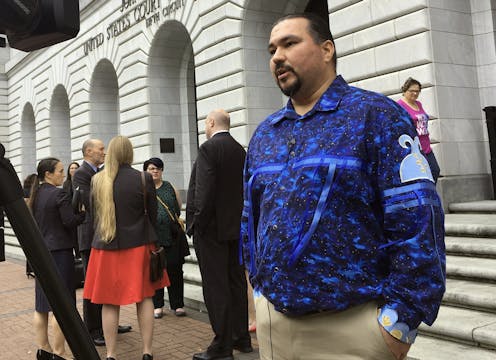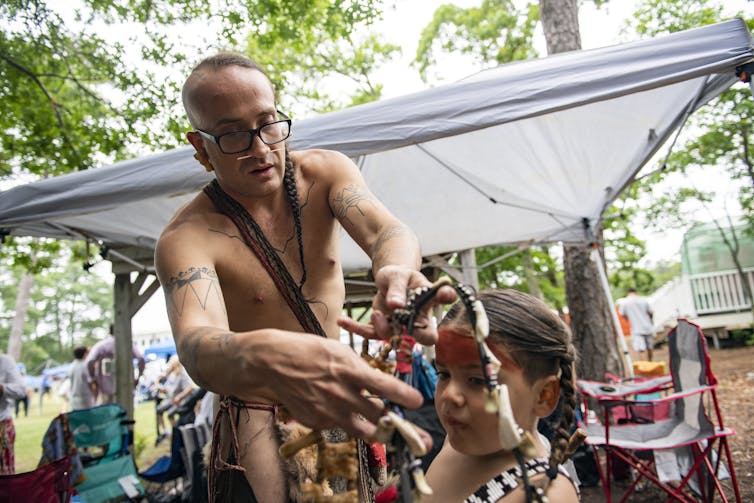Native American children's protection against adoption by non-Indian families is before the Supreme
A case before the Supreme Court will determine whether a federal law meant to protect Native American children from being forcibly removed from their families is constitutional.

The Supreme Court is about to hear arguments about the constitutionality of a 1978 law enacted to protect Native American children in the U.S. and strengthen their families.
That law, the Indian Child Welfare Act, was originally passed by Congress in response to requests from tribal leaders and other advocates for Native Americans to stop states from removing Indian children from their families.
Now, in the case before the Supreme Court, non-Indians seeking to adopt or foster Indian children have challenged provisions of the law. The non-Indians say the law illegally discriminates against the Indian children based on their race and tells state officials what to do. As a federal Indian law scholar and the mother to two Indian children, I know that Indian status is a political, not a racial, designation.
The case threatens to reverse the social and health benefits experienced by Native children when raised in their tribal cultures. It could also limit Congress’ ability to enact laws affecting tribal governments and their citizens.
A Native American child welfare crisis
In the 1970s, Native American tribes sought help from Congress because many state governments were removing American Indian children from their families and communities and placing them in homes with white families. State social welfare agencies often permanently removed children from Native families without evidence of harm or neglect because they did not understand Native cultural and child-rearing practices. At times, social workers even used force to remove the children from their families.
This happened to between 25% and 35% of all Native American children, and 90% of those removed were sent to be raised by non-Indian families.
In Minnesota, for instance, the state took Indian children from their families to be placed into foster care or for permanent adoption at five times the rate they did non-Indian children. In South Dakota and Montana, Indian children were 13 times as likely to be placed in foster care than non-Indian children. And in Washington state, the adoption rate was 19 times as high and the foster care placement rate 10 times as high for Indian children than non-Indians.
As a result of these policies and practices, many Indian adults and children suffer trauma because of the loss of connections with their families and their cultures. This forced separation led many of them to struggle with addiction and violence throughout their lives.
Some Indian children spent years trying to recover their Indian identities and reconnect with their tribal communities. Many others never made it home to see their families or communities again.
It was this situation that the Indian Child Welfare Act aimed to address.

The law, explained
The law first sets out the government-to-government relationship Native American nations have with the United States. Each is a sovereign nation dealing with the other’s government. As explained in the law, the United States government has a trust relationship, or obligation to protection Native lands, sovereignty, and peoples, based on treaties, statutes and court decisions.
In setting out a goal of reducing the number of children removed from their Native families and communities, the law “declares that it is the policy of this Nation to protect the best interests of Indian children and to promote the stability and security of Indian tribes and families,” and goes on to say that “there is no resource that is more vital to the continued existence and integrity of Indian tribes than their children.”
The law covers foster care placements, preadoptive placements, termination of parental rights and adoptive placements, but not custody disputes between parents. It defines Indian children as citizens of or children eligible for enrollment as citizens in a tribal nation.
When an Indian child lives on a reservation, the law declares that tribal courts must decide the child’s placement, including whether they are removed from their family in the first place. The tribal court can place the child with a non-Native relative or a non-Native family.
When an Indian child does not live on a reservation, either the state or the tribal government can decide the placement of the child. If the parent or tribe requests, the state courts must transfer child welfare cases to a tribal court, with a few limited exceptions.
The law sets uniform standards for courts to follow when they decide Indian child welfare cases. These standards include provisions that ensure that tribal governments are aware of and can have a say in the placement of Indian children. They aim to reduce the trauma of family and tribal separation by instructing courts to make active efforts to keep families together. These standards include recommending courts place children with their relatives – either Indian or non-Indian – someone in their tribe, or an Indian family if possible.
The preferences for family preservation and reunification pioneered in this law represent the gold standard for child welfare, according to experts in social work, psychology and family law. They agree that family reunification promotes the best outcomes for all children and that maintaining family and community connections best serve a child’s needs. Studies show that Native children raised in Native homes have higher rates of self-esteem and are less likely to suffer from depression or substance abuse or commit suicide.
Not following the law
In the 40-plus years since its enactment, however, states have regularly failed to follow the law.
For example, in 2015, a federal judge ordered the state of South Dakota to comply with the law after the state failed to provide parents with adequate notice and custody hearings.
Many state social workers and family court judges lack training in and knowledge about the law. Some do not understand the harm Indian children experience when they are not raised in their culture. Others believe that the economic benefits that non-Indian parents can provide are in the best interests of the child and overlook the benefits Indian children gain from being raised within their cultures and communities.
The U.S. government does not keep records on the law’s implementation or monitor its compliance. The available data from the Casey Foundation, which which advocates for the “well-being of children, families and the communities where they live,” shows states vary in their efforts to follow the law. A few have adopted state laws to require compliance, but others have yet to fully embrace the law. Uneven implementation of the law has undermined its ability to prevent family separation.
Recent studies show that Indian children remain overrepresented in the foster care system. A 2021 report found that Indian children disproportionately enter the child welfare system and are removed from their homes at up to three times the rate of white children. The National Indian Child Welfare Association has similarly reported high rates of Native children in the foster care system.
The poor, often nonexistent, implementation combined with the recent constitutional challenges to the law suggests a lack of public awareness about the law and the harms that it was intended to remedy. That lack of understanding has allowed non-Natives to attack the law as unconstitutional. Now the Supreme Court has agreed to hear their claims and will decide whether Indian children will continue to gain the benefits of growing up knowing their Native cultures and communities.
Kirsten Matoy Carlson does not work for, consult, own shares in or receive funding from any company or organization that would benefit from this article, and has disclosed no relevant affiliations beyond their academic appointment.
Read These Next
As DOJ begins to release Epstein files, his many victims deserve more attention than the powerful me
Powerful men connected to Jeffrey Epstein are named, dissected and speculated about. The survivors,…
How to reduce gift-giving stress with your kids – a child psychologist’s tips for making magic and a
Depending on family circumstances and a child’s personality type, gift giving runs the gamut of fun…
The world risks forgetting one of humanity’s greatest triumphs as polio nears global eradication − 7
Polio may finally be defeated in the next 5 years. Will the world recognize what an extraordinary achievement…





